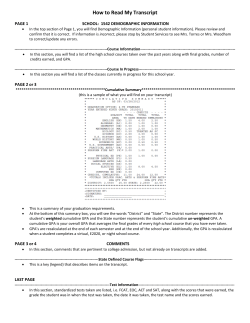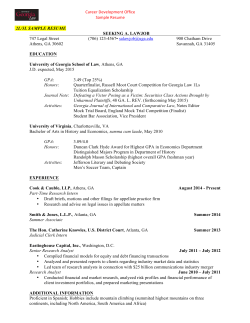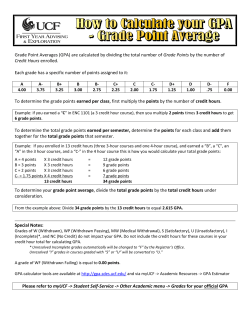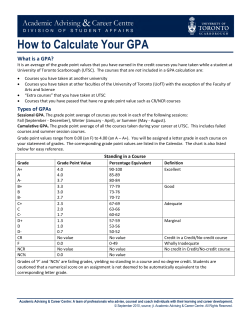
Acknowledgements Engineering Education Research in the AWAKEN Project Clarion Call for Education Reform
Engineering Education Research in the AWAKEN Project Mitchell J. Nathan University of Wisconsin - Madison The AWAKEN Project Funded by the National Science Foundation Acknowledgements Co-Investigators Graduate Students • L. Allen Phelps • Sandra Courter • • • • • Amy Prevost Amy Atwood Natalie Tran (CSUB) Kyle Oliver Benjamin Stein Funding from NSF Division of Engineering Education & Centers AWAKEN 1. Curriculum Response – In 2006, $1.3B for career & technical education (CTE) programs in every state in the US. • National Research Council’s (2007) Rising Above the Gathering Stormcalls for educational leaders to optimize knowledge-based resources and energize the STEM career pipeline. Project Lead the Way Competing Hypotheses • Control for student prior achievement & other student & teacher characteristics. • Enriched Integration Hypothesis: higher standardized test scores in mathematics and science than the students who are not taking any PLTW courses • Insufficient Integration: No advantage • Adverse integration: Lower for PLTW students – Curriculum for middle and high school. – Over 17% of US high schools, in 50 states – 7 HS courses qualify for credit at accredited colleges. • Do PLTW students achieve both academic & occupational competencies? • Is enrollment in PLTW associated with enhanced math and science achievement? M J Nathan Study Sample #1 – Treatment N = 70 Ss with one or more PLTW class – Control N = 70 Ss with no PLTW, matched on DV measures • Perkins Vocational Education Act mandates that technical and academic education be integrated “so that students achieve both academic and occupational competencies." AWAKEN • NRC: PLTW as “a model curriculum.” • Project Lead the Way (PLTW): • US urban district: African American 57%, Hispanics 22%, White 12%, Asian 4%, other 4% • Free/Reduced Lunch Program 72% • All high schools certified in PLTW (N = 5) • Level 1: Students (N = 140) Clarion Call for Education Reform AWAKEN Data & Design • Multi-level analysis • Dependent Variable: – Grade 10 achievement in Math & Science • Independent Variables: – Level 1 Student: Race, Sex, F/R Lunch, Special Ed – Covariate: Grade 8 Math & Science achievement – Level 2 Classroom: Teacher Experience • Level 2: Classroom (N = 27) • Correlational study: No random assignment, so causal inferences are not supported AWAKEN AWAKEN – Selection bias reduced with propensity score matching * Working with District Data * • Confidentiality issues – “Cooperative agreement” with district – School board approval • Technical issues – Size of data set – Merging across databases – Missing data & quality control: BIG problems – Massive time commitment from technician • Giving back to the district Selection Bias in Control Group • Propensity score matching (PSM) technique • PSM: conditional probability of assignment to treatment given a set of observable covariates. • Propensity scores from the group of students with complete data (N = 772). • Matched prior achievement PLTW Control-PSM Math 508.7 509.19 Science 368.8 372.5 • Match on free/reduced lunch program, gender. Data Analysis: Level 1 • Achievement = β0 + β1Prior Achievement + β2Female + β3Free/Reduced Lunch + β4PLTW + R • Predictors were grand-mean centered • β0: Grand mean of student achievement Data Analysis: Level 2 • • • • • β0 = γ00 + γ01Years_Experience + U0 β1 = γ10 β2 = γ20 β3 = γ30 β4 = γ40 • Classroom mean achievement regressed on teacher years of experience and the classroom residual variance (U0). • Slopes for Level 1 factors (β1- β4) treated as fixed Results Results • For group (N = 140) significant achievement gains from 8th grade to 10th grade in math (p< 0.01) and science (p< 0.01) (Paired t). • Moderately high correlations between 8th grade and 10th grade achievement (0.73 math, 0.77 for science) • Variation at the classroom (teacher) level. • 21% (math) to 31% (sci) of σ2 in student achievement at classroom level. • However, after controlling for student prior achievement and student characteristics, decreases to about 9% to 8%. • Gains in math overall (8th to 10th), p< .05, • But lower for PLTW, p< .05. AWAKEN AWAKEN AWAKEN Results: Math Achievement Results: Math Achievement Results: Science Achievement Results: Achievement • Controlling for student and teacher DVs, PLTW showed a (relative) mean decreaseof 10.76 points in 10th grade scores, compared to non-PLTW students. • No difference between students enrolled in one or more than one PLTW class (p = 1). • Gains in science overall. • Lower for PLTW students, but n.s. • Smaller gains in Math achievement for PLTW students contradicts the Enriched Integration Hypothesis that PLTW enrollment contributes to higher math achievement. • Math: Most direct support for the model that follows from the Adverse Integration Hypothesis. • Science: Most direct support for the model derived from Insufficient Integration Hypothesis. AWAKEN AWAKEN AWAKEN Study #2: Replication • Sample: 70% White, 24% F/R Lunch, 2% ELL; city rated highest rate of PhDs in US • Multiple regression analysis (N = 176), due to lack of variability across classrooms • Factors: prior achievement, free/reduced lunch eligibility, special ed& gender. • PLTW (n=57) and non-PLTW (n=119) matched using PSM; only gender differed. Results: Math • Gains in math overall, p< .01 • PLTW is sig. predictor, p = .05. • Along with F/R L, p< .01 Results: Science • Gains in science overall, p< .01 • PLTW not a sig. predictor of achievement AWAKEN Conclusions: Achievement • For math, enriched integration hypothesis – Opposite of findings from low-SES sample! – Different analytical models were applied • In science, insufficient integration fits best • Need to explore relation of PLTW to math across a broader sample. • Data do not support policies to use PLTW and other pre-engineering courses to satisfy science graduation requirements. • • • • Correlational – no random assignment Small-ish sample sizes (missing data) Studies limited to Midwest region (tho’ vary SES) Curriculum is more than which books you use – Teacher training: pedagogy and content knowledge – Classroom learning and instruction – Assessment design and match to curriculum AWAKEN Match to State Assessment 10th • Reviewed all released grade items on state achievement assessments. • Standardized achievement tests align most closely with academic course material and content standards. • These items may fail to capture important aspects of engineering preparation. • Could explain null result, but not the significantly smaller gains in study #1. Insufficient and Adverse Integration Limitations • Why do PLTW students show mixed, low, or no achievement gains? 1.Match of the course to achievement tests. – Want a test that control Ss took pre / post. 2.Lack of math in the engineering courses. 3.Lack of explicit connections between the math and the engineering content. AWAKEN Math Content “Explicit Integration” of Math • How much math is present in engineering curriculum? • What is the level of math that is used? • Is the math explicitly connected for the student to the engineering activities? • Places in the curriculum where materials and instruction specifically point to a mathematics principle, law, or formula, and depict how it is used to carry out or understand an engineering concept, task or skill. AWAKEN AWAKEN Transfer The Manifold Curriculum • When assessment items share both surface features and deep structure with training tasks, “near transfer” is supported. • When surface features & context change (“far transfer”), students fail to notice matches with deep structure (CTGV, 1997). • To develop transfer, novices require explicit instruction, frequent practice and timely feedback (Pellegrino et al. 2001). • Curriculum analyses (Porter, 2004) can be divided into the study of 4 different aspects: – Intended curriculum – Assessed curriculum – Enacted curriculum – Learned curriculum Samplefrom IED Unit 6, for Algebra standard Area No. Scored Items (X) Opps. for Explicit Integration (N) % Integration Teacher Training 0 26 0 Planning 3 25 12% Activities 2 5 40% Assessment 1 4 25% – Planning materials: • Anticipatory set; • Concepts and performance objectives; • Daily lesson plans and planned presentations. – Classroom activities: • Hands-on projects; • Worksheets. – Teacher training materials: • Training documents; Activities; Projects; • Self-Assessment and Self-Reflection Items. AWAKEN Intended Curriculum: Method Intended Curriculum AWAKEN Intended Curriculum: Results Enacted Curriculum Student Materials • Year 1 Math content is light, limited to a few standards (geometry, number & operations, meas), & poorly integrated • Years 2 & 3, more math, more advanced math, and much better explicit integration with engineering Teacher Training Materials • Years 1 & 2 content standards: 31% or less integtation. – Content: Geometry, Number, Measurement • Year 3 (digital el.) 83% explicit integration. – Content: Number and Algebra content; prop. calculus – Process: Representation and Connections AWAKEN Enacted Curriculum: Results • Analyzed 4 lessons from Intro course (4 more!) • Overall, 34 math concepts (content standards) were identified – Geometry (17), Measurement (7), Number & Operations (10). • Less than 33% of math concepts integrated. – Often, very basic ideas (parts of geometric objects, or number operations). – Advanced ideas (projective geometry, set theory) were most often implicitly embedded within procedures and software operations. Assessed Curriculum • Data: Formative, summative assessments: – Projects; – Presentations given by students; and – Written examinations. Q1. Do assessments allow students to demonstrate connections of math (and science) concepts to engineering? Q2. Is there alignment between the intended curriculum and PLTWs own assessments? Assessed Curriculum: Results • – – – IED: Better than the other foundations courses! Content: Geometry (29%) & Measure (17%) Process: 21% for Repn and Commun. Disconnect of class (5%) & assessments (29%) • POE: Integrated activities but not assessed – Disconnect with assessment the other way! • DE: Not much overlap with math standards – Assessments down from 8% (Algebra) to 0% (Measurement, and Data/Probability). Insufficient and Adverse Curriculum Integration Conclusions: Curriculum • Students show little benefit in math achievement from limited & embedded experiences. • Assessments tend to favor academic focus. • Even PLTW’s own assessments not well aligned. • Math is present but limited content and basic demands, especially in Year 1. • More math content in later years, but smaller enrollment in advanced engineering courses. • Math is usually implicitly embedded in software, instrumentation, instruction & printed materials. • Lack of explicit connections between academic and technical courses may reinforce the different skills and knowledge valued in Tech Ed vs. college preparation (high-stakes assessments). • May feed attitudes counter to math and science learning, and expect that the technology will or should do the math for them. • Especially problematic for students already exhibiting low math achievement. Next Steps: Curriculum • Consider assessments that better align with expectations of the math (and science) in engineering and technical education. • Many math content standards go untapped in engineering. • Examine impact of explicit integration in curriculum design and teacher training (Stone 2008). – Professional development teams – Curriculum redesign teams (with kibitzing) AWAKEN End of Part 1 www.engr.wisc.edu/services/elc/hple ngr.htm 2. PedagogicalResponse • What are teachers thinking, anyway? Aim #2: Teacher Beliefs Student factors influence teacher decisions How beliefs change with PLTW instruction • Instructional practice and teacher decision making are influenced by teachers’ beliefs about learning and instruction. • For EEd reform, necessary to study and incorporate teachers' attitudes and beliefs about engineering instruction and learning. • JEE editorial: Need to understand the “engineering teaching culture.” Aim #2: Teacher Beliefs Method Method: Likert Scale 1. Develop an instrument that identifies a reliable set of constructs 2. Document teachers’ beliefs & expectations 3. * Identify differences among teachers • Engineering Education Beliefs and Expectations Instrument – EEBEI • On-line survey, 84 forced-choice items • Spring 2008; Participants offered $10 • N = 144 high school teachers from Midwest • White (93%), Male (58%) • Science (65%), Math (41%), Tech Ed (36%) • What is the nature of high school teachers’ beliefs and expectations about preparation for engineering study and career success? Mitchell J. Nathan University of Wisconsin - Madison The AWAKEN Project Funded by the National Science Foundation – Technical education v. traditional college preparation in math and science (MS) 4. * Document changes that occur with PLTW training and instruction AWAKEN • Frequency items (5-point scale) – The math content taught in my courses is explicitly connected to engineering. – 1 (Never) 2 (Almost Never) 3 (Sometimes) 4 (Often) 5 (Almost Always) • Agreement items (7-point scale) – To be an engineer a student must have high overall academic achievement. – 1 (Strongly disagree) 2 (Disagree) 3 (Somewhat disagree) 4 (Neutral) – 5 (Somewhat agree) 6 (Agree) 7 (Strongly agree) Results: Likert Scale Conclusions: Likert Scale M α + .70 B. Student background, interests influence my instruction. 0 .83 C. Student science/math/technical learning takes place in out-of-school contexts. ++ .78 D. Students need high academic achievement in math and science courses to be an engineer. ++ .83 E. Student social background affects pursuit of engineering. + .80 F. Science and math content taught in my courses is explicitly connected to engineering. + .92 G. Schools provide adequate environmental and structural support for engineering. - .78 A. Student academic abilities influence my instruction. Results: Recommend Enroll Teachers believe that -• Students’ interests, culture & family, and academic performance guide their instruction. • Engineering prep. takes place in multiple academic courses and community settings. • Eng. students need high academic achievement. • Being male, white or Asian, child of an engineer increases likelihood of entering engineering. • A minority of teachers report they adequately integrate math & science with engineering activities. Results: Recommend Enroll Method: Vignettes Academic V1 Gender: Male Grade: 10th Background: low SES GPA: 3.85 Interests: To enroll in Principles of Engineering course; attend college. Social V2 Gender: Female Grade: 11th Background: high SES GPA: 3.45 Interests: To enroll in Digital Electronics course; thinks father’s work as an engineer is “cool.” V3 Gender: Male Grade: 10th Background: low SES GPA: 1.35 Interests: Assembling body kits on foreign cars; attend college. V4 V4 Gender: Female Grade: 11th Background: low SES GPA: 3.45 Interests: To enroll in Digital Electronics course; uninterested in her parents’ blue-collar jobs. Results: Decision Influences • Compare academic: low-SES males (V1 v. V3) Significantly more teachers recommend enrollment for V1 (hi GPA) than V3 x2McNemar(1) = 31.24, p = .000. • Compare social: Hi GPA females (V2 v. V4) Teachers were more likely to recommend enrollment for V2 (high SES) than V4 x2McNemar(1) = 6.667, p = .001 M J Nathan M J Nathan Results: Decision Influences • Varied use of academic (GPA) & social (SES) factors • Academic factors, p = .000 – High GPA (V1), 75% report using academic. – Low GPA (V3), 20-30% report using academic. • Social factors, p = .000 – 0% report using SES to recommend enrollment – For the more privileged student (V2), 50-73% reported using academic factors – For low SES (V4), 25-42% teachers reported using academic factors. Conclusions: Vignettes Teacher Differences • More situated, tacit assessment of teacher views • When explicitly asked, (SES) was never a factor in teachers’ decisions, family background was somewhat, and academic performance was frequently cited. • But, when comparing vignettes -- • Compare MS (n = 97) v. PLTW (n = 47). • MS less likely to identify sources of support for engineering in their schools (G), p<.01. • MS agreed more strongly an engineer needs high achievement in math, science and technology (D), p<.0001. • PLTW more likely to claim that science and math content was integrated with the engineering content (F) , p<.05. – Academic factors were applied unevenly across SES – Social factors influenced teacher decisions, even for students with comparable (high) academic records. AWAKEN Teacher Change • Before/after intensive summer institute & initial semester (fall) of PLTW instruction. • National sample (N=84): 87% white 60% male • Positive changes in 3 constructs (n=47): 1.More explicitly connect science & math to engineering (F), p<.01 2.Greater support from their schools (G), p<.01 3.Instruction is more responsive to students’ academic abilities (A), p<.05 Conclusions: Teacher Beliefs • Developed a reliable instrument to document teachers’ views, identify group differences, and track changes in beliefs. • Influences of student SES and academics • Teachers may be over-confident in their integration of math & science with engineering – And PLTW training may amplify this AWAKEN Limitations • Teachers’ notions of “engineering” – Use with another instrument developed by Yasar, Baker et al. (2006) • Teachers’ influences on student coursetaking and career pursuits – Guidance counselors’ views • Order effects of vignettes • Expand to a national, longitudinal sample AWAKEN Study Sample www.engr.wisc.edu/services/elc/hple ngr.htm Assessed Curriculum: Results • – – – IED: Better than any of the other areas of analysis Content: Geometry (29%) & Measure (17%) Process: 21% for Repn and Commun. Disconnect of class (5%) & assessments (29%) • POE: Integrated activities but not assessed – Disconnect with assessment the other way! • DE Mitchell J. Nathan – Assessments down from 8% (Algebra) to 0% (Measurement, and Data/Probability). University of Wisconsin - Madison The AWAKEN Project Funded by the National Science Foundation AWAKEN Enacted Curriculum: Method • Videos segmented into clips. • Coding system applied to each clip: – Instruction time codes • Lecture, tutorial, class management, non-interact – Concepts (“big ideas”); whether math concepts are explicitly integrated during instruction. • Engineering or Math – Skills address process-oriented activity. • Engineering or Math AWAKEN Enacted Curriculum: Results Instructor’s time mostly on class management AWAKEN Enacted Curriculum: Results • About three times more instructor contact time was devoted to skills (73 mins, 93 clips) than concepts (26 mins, 48 clips). • 64% clips coded as skills but not concepts. • 31% clips coded as concepts but not skills. • Thus, concepts generally grounded in skills, but skills were more likely to be taught with no conceptual basis. AWAKEN Enacted Curriculum: Results • Topically, when instruction on engineering, skills (101 clips) were emphasized over concepts (22 clips), and occupied more time. • When focus was on math, concept codes (34 clips) were more frequent than skills codes (4 clips), and occupied more time. AWAKEN Enacted Curriculum: Results (1) Instructor’s time mostly on class management (non-instructional) tasks. (2) Overall, most observed instruction time was devoted to skills than to concepts. (3) Math concepts vs. engineering skills. (4) Only a small fraction of instruction that linked math concepts to engineering coursework made those links explicit, usually limited to basic topics in math.
© Copyright 2025












